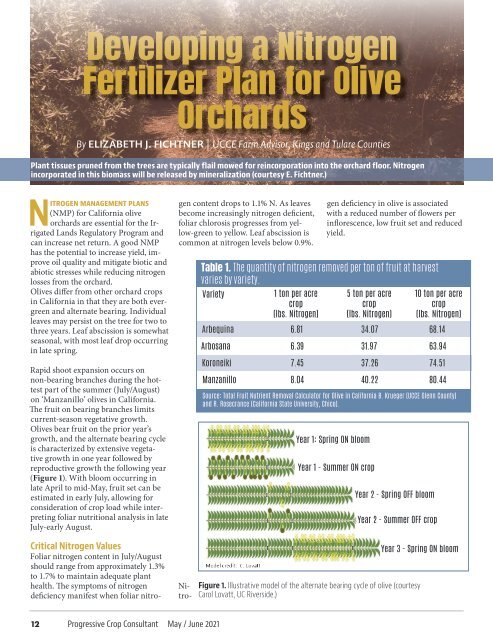Progressive Crop Consultant May/June 2021
You also want an ePaper? Increase the reach of your titles
YUMPU automatically turns print PDFs into web optimized ePapers that Google loves.
Developing a Nitrogen<br />
Fertilizer Plan for Olive<br />
Orchards<br />
By ELIZABETH J. FICHTNER | UCCE Farm Advisor, Kings and Tulare Counties<br />
Plant tissues pruned from the trees are typically flail mowed for reincorporation into the orchard floor. Nitrogen<br />
incorporated in this biomass will be released by mineralization (courtesy E. Fichtner.)<br />
Nitrogen management plans<br />
(NMP) for California olive<br />
orchards are essential for the Irrigated<br />
Lands Regulatory Program and<br />
can increase net return. A good NMP<br />
has the potential to increase yield, improve<br />
oil quality and mitigate biotic and<br />
abiotic stresses while reducing nitrogen<br />
losses from the orchard.<br />
Olives differ from other orchard crops<br />
in California in that they are both evergreen<br />
and alternate bearing. Individual<br />
leaves may persist on the tree for two to<br />
three years. Leaf abscission is somewhat<br />
seasonal, with most leaf drop occurring<br />
in late spring.<br />
Rapid shoot expansion occurs on<br />
non-bearing branches during the hottest<br />
part of the summer (July/August)<br />
on ‘Manzanillo’ olives in California.<br />
The fruit on bearing branches limits<br />
current-season vegetative growth.<br />
Olives bear fruit on the prior year’s<br />
growth, and the alternate bearing cycle<br />
is characterized by extensive vegetative<br />
growth in one year followed by<br />
reproductive growth the following year<br />
(Figure 1). With bloom occurring in<br />
late April to mid-<strong>May</strong>, fruit set can be<br />
estimated in early July, allowing for<br />
consideration of crop load while interpreting<br />
foliar nutritional analysis in late<br />
July-early August.<br />
Critical Nitrogen Values<br />
Foliar nitrogen content in July/August<br />
should range from approximately 1.3%<br />
to 1.7% to maintain adequate plant<br />
health. The symptoms of nitrogen<br />
deficiency manifest when foliar nitrogen<br />
content drops to 1.1% N. As leaves<br />
become increasingly nitrogen deficient,<br />
foliar chlorosis progresses from yellow-green<br />
to yellow. Leaf abscission is<br />
common at nitrogen levels below 0.9%.<br />
Nitro-<br />
gen deficiency in olive is associated<br />
with a reduced number of flowers per<br />
inflorescence, low fruit set and reduced<br />
yield.<br />
Table 1. The quantity of nitrogen removed per ton of fruit at harvest<br />
varies by variety.<br />
Variety<br />
1 ton per acre<br />
crop<br />
(lbs. Nitrogen)<br />
Arbequina 6.81<br />
Arbosana<br />
Koroneiki<br />
Manzanillo<br />
6.39<br />
7.45<br />
8.04<br />
5 ton per acre<br />
crop<br />
(lbs. Nitrogen)<br />
34.07<br />
31.97<br />
37.26<br />
40.22<br />
Year 1: Spring ON bloom<br />
Year 1 - Summer ON crop<br />
Year 2 - Spring OFF bloom<br />
Year 2 - Summer OFF crop<br />
10 ton per acre<br />
crop<br />
(lbs. Nitrogen)<br />
68.14<br />
63.94<br />
74.51<br />
80.44<br />
Source: Total Fruit Nutrient Removal Calculator for Olive in California B. Krueger (UCCE Glenn County)<br />
and R. Rosecrance (California State University, Chico).<br />
Year 3 - Spring ON bloom<br />
Figure 1. Illustrative model of the alternate bearing cycle of olive (courtesy<br />
Carol Lovatt, UC Riverside.)<br />
12 <strong>Progressive</strong> <strong>Crop</strong> <strong>Consultant</strong> <strong>May</strong> / <strong>June</strong> <strong>2021</strong>


















